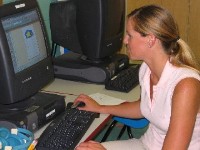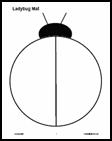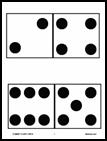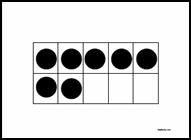
Recent Additions to Mathwire.com
Added on 1/28/06: Black History Month: Freedom Quilt Resources

- Quilting:
- See Freedom Quilts for a discussion of freedom quilts, children's literature and links to internet sites that discuss the use of quilts as secret codes for the Underground Railroad.
 Freedom Quilt Challenge challenges students to use slides, flips and turns to recreate the Flying Geese pattern using a single half white/half black quilt square.
Freedom Quilt Challenge challenges students to use slides, flips and turns to recreate the Flying Geese pattern using a single half white/half black quilt square.
 Freedom Quilts lesson plan from the Kennedy Center that introduces students to the most popular quilt patterns used by the Underground Railroad.
Freedom Quilts lesson plan from the Kennedy Center that introduces students to the most popular quilt patterns used by the Underground Railroad.
A study of quilting centers on the geometric use of slides, flips, turns and color patterns created by congruent squares and triangles. Students learn to identify these geometric transformations as they reproduce traditional quilt block patterns or create their own original patterns.
Freedom quilts and the history of their use by the Underground Railroad as a secret code for fugitive slaves relates geometry, literature and history, providing an interdisciplinary approach to this important topic.
Added on 1/25/06: Open-Ended Problems Resources
 Pattern Block Fraction Design requires students to fill a shape with pattern blocks to create a design that meets certain requirements. Students must also write a fraction that describes the part of the total design represented by each different color pattern block.
Pattern Block Fraction Design requires students to fill a shape with pattern blocks to create a design that meets certain requirements. Students must also write a fraction that describes the part of the total design represented by each different color pattern block.
 Spinner Game presents students with a frequency table of spins and requires students to create a bar graph of the results and draw a spinner that would yield those results. Students must justify their proposed spinner, explaining how it fits the data.
Spinner Game presents students with a frequency table of spins and requires students to create a bar graph of the results and draw a spinner that would yield those results. Students must justify their proposed spinner, explaining how it fits the data.
 Fraction Game simulates a Fraction War game but students must draw a representation of each fraction and explain who won, based on the drawings.
Fraction Game simulates a Fraction War game but students must draw a representation of each fraction and explain who won, based on the drawings.
Added on 1/24/06: More Number Sense Resources

 Ladybug Math student workmat and recording sheet to introduce young students to the concept that numbers can be written as the sum of two other numbers. Students place "spots" on each side of the ladybug, then say and/or write a number sentence about the total number of spots on their ladybug. The ladybug recording sheet can be used to record student work on mats, adding a picture representation to the concrete manipulative work on the mat.
Ladybug Math student workmat and recording sheet to introduce young students to the concept that numbers can be written as the sum of two other numbers. Students place "spots" on each side of the ladybug, then say and/or write a number sentence about the total number of spots on their ladybug. The ladybug recording sheet can be used to record student work on mats, adding a picture representation to the concrete manipulative work on the mat.
Added on 1/23/06: Number Sense Resources


 Ten Frame Mat and Double TenFrame Mat to help students develop a concept of our system of tens
Ten Frame Mat and Double TenFrame Mat to help students develop a concept of our system of tens
 Demo Ten Frame cards for teacher use in number sense activities that use ten frames. Print out the ten frames on card stock and laminate for durable use.
Demo Ten Frame cards for teacher use in number sense activities that use ten frames. Print out the ten frames on card stock and laminate for durable use.
 Domino Mat for student use in creating dominoes and writing number sentences.
Domino Mat for student use in creating dominoes and writing number sentences.
 Demo Domino Cards for teacher use in number sense activities that use dominoes. Print out the dominoes on card stock and laminate for durable use.
Demo Domino Cards for teacher use in number sense activities that use dominoes. Print out the dominoes on card stock and laminate for durable use.
Added on 1/23/06: Coin Flipping Activities
This new Mathwire.com webpage begins a collection of activities that examine the probability of coin tosses. Activities include Heads & Tails Data Collection, Heads & Tails Game, links to the Franklin Institute Coin Flipping Results and a Coin Flip Game that uses ten frames to reinforce the concept that ten pennies can be exchanged for a dime.
- See more information on Coin Flipping Activities
Added on 1/22/06: February Math Activities

- Visit February Math Activities webpage for activities and links to activities on the web.
 Pascal's Hearts challenges students to fill in the missing numbers, using the patterns of Pascal's triangle.
Pascal's Hearts challenges students to fill in the missing numbers, using the patterns of Pascal's triangle.
 Olympic Logo develops discrete math skills as students are challenged to traverse this network without lifting their pencils or retracing a section of the logo. Students must explain if this is possible and how they are certain their answer is correct.
Olympic Logo develops discrete math skills as students are challenged to traverse this network without lifting their pencils or retracing a section of the logo. Students must explain if this is possible and how they are certain their answer is correct.
 Ice Skating Champs investigates the use of median to score ice skating championships.
Ice Skating Champs investigates the use of median to score ice skating championships.
Added on 1/17/06: Gr. 3-4 Resources:
 Pattern Block Symmetry: students must create a pattern block design to satisy the given conditions involving line symmetry and the number of different pattern block pieces used.
Pattern Block Symmetry: students must create a pattern block design to satisy the given conditions involving line symmetry and the number of different pattern block pieces used.
 Shape Capture Game is a simplified version of Battleship in which each partner plots a quadrilateral then tries to guess both the location and type of quadrilateral his/her opponent drew. Each player names an ordered pair and marks the gamesheet to record whether the point is a vertex, inside, outside or on the lines of the quadrilateral. Play alternates back and forth until one player has found all four vertices and correctly identifies his/her opponent's quadrilateral.
Shape Capture Game is a simplified version of Battleship in which each partner plots a quadrilateral then tries to guess both the location and type of quadrilateral his/her opponent drew. Each player names an ordered pair and marks the gamesheet to record whether the point is a vertex, inside, outside or on the lines of the quadrilateral. Play alternates back and forth until one player has found all four vertices and correctly identifies his/her opponent's quadrilateral.
Added on 1/16/06: Kindergarten Problem Solving:
 Pattern Problems: visual patterns that require students to draw what comes next. Teachers should ask students to explain how they know what comes next to develop students' ability to explain their thinking.
Pattern Problems: visual patterns that require students to draw what comes next. Teachers should ask students to explain how they know what comes next to develop students' ability to explain their thinking.
 Animal Problems ask students to solve problems about pets and animals.
Animal Problems ask students to solve problems about pets and animals.
 Shape Patterns: shape patterns that require students to draw what comes next. Teachers should ask students to explain how they know what comes next to develop students' ability to explain their thinking.
Shape Patterns: shape patterns that require students to draw what comes next. Teachers should ask students to explain how they know what comes next to develop students' ability to explain their thinking.
 Food Problems: students solve problems that relate to food, drawing to figure out how many cookies, pizza, cupcakes were eaten in all.
Food Problems: students solve problems that relate to food, drawing to figure out how many cookies, pizza, cupcakes were eaten in all.
 Winter Fun problems use snowmen, sleds and mittens to engage kindergarteners in problem solving.
Winter Fun problems use snowmen, sleds and mittens to engage kindergarteners in problem solving.
Added on 1/13/06: Grade 3 Resources:
 Multiplication Facts Tests: 3 different versions that test the easiest multiplication facts.
Multiplication Facts Tests: 3 different versions that test the easiest multiplication facts.
 Money-Change Problems require students to find the sum of several purchases then calculate the correct change.
Money-Change Problems require students to find the sum of several purchases then calculate the correct change.
Added on 1/7/06: Open-ended Problems from Franklin Institute Online:
 Open-ended Math Problems from the Franklin Institute Online offers monthly problems in Number Theory; Geometry; Measurement; Patterns, Algebra & Functions; Data, Statistics & Probability. The site offers three different levels of difficulty for each strand.
Open-ended Math Problems from the Franklin Institute Online offers monthly problems in Number Theory; Geometry; Measurement; Patterns, Algebra & Functions; Data, Statistics & Probability. The site offers three different levels of difficulty for each strand.
Added on 1/7/06: Multiplication & Division Games:
 Target 300: this Math Solutions game develops students' estimation skills as they choose to multiply each die toss by 10, 20, 30, 40, or 50 so that the sum of all six tosses will be the closest to 300.
Target 300: this Math Solutions game develops students' estimation skills as they choose to multiply each die toss by 10, 20, 30, 40, or 50 so that the sum of all six tosses will be the closest to 300.
 Closest to 1000: this Math Solutions game challenges students' understanding of multiplication and helps develop estimation skills as they select appropriate starting numbers and multipliers to get closest to 1000 at the end of two multiplications. Students use calculators for the multiplication problems as this game focuses on students' ability to think about multiplication and estimate the outcome of the double multiplication before using the calculator.
Closest to 1000: this Math Solutions game challenges students' understanding of multiplication and helps develop estimation skills as they select appropriate starting numbers and multipliers to get closest to 1000 at the end of two multiplications. Students use calculators for the multiplication problems as this game focuses on students' ability to think about multiplication and estimate the outcome of the double multiplication before using the calculator.
 Leftovers with 100: this Marilyn Burns game challenges students to choose divisors to create the largest remainder since the remainder is the student's score for the round. As with many good math games, students will ponder the choices and mentally calculate several possibilities in the search for the optimal divisor that yields the largest remainder and the most points.
Leftovers with 100: this Marilyn Burns game challenges students to choose divisors to create the largest remainder since the remainder is the student's score for the round. As with many good math games, students will ponder the choices and mentally calculate several possibilities in the search for the optimal divisor that yields the largest remainder and the most points.
 One Time Only: this Math Solutions game provides practice in identifying factors as students successively write down factors of the current number and try not to lose by being the person who cannot write a factor that has yet to be used in the game.
One Time Only: this Math Solutions game provides practice in identifying factors as students successively write down factors of the current number and try not to lose by being the person who cannot write a factor that has yet to be used in the game.
Added on 1/7/06: Addition & Subtraction Games:
 Game of More: this Math Solutions game raises the Top-It (or War) game to a new level as students identify which player has more. That player figures out how many more he/she has and takes that many cubes. Players create cube trains and record the difference in a chart. The player with the most cubes after all cards have been played wins the game.
Game of More: this Math Solutions game raises the Top-It (or War) game to a new level as students identify which player has more. That player figures out how many more he/she has and takes that many cubes. Players create cube trains and record the difference in a chart. The player with the most cubes after all cards have been played wins the game.
 Game of Tens and Ones: this Marilyn Burns game challenges students to add or subtract 10 or 1 and move appropriately on a hundred board.
Game of Tens and Ones: this Marilyn Burns game challenges students to add or subtract 10 or 1 and move appropriately on a hundred board.
Added on 1/6/06: Pattern Block Open-Ended Assessments
 Pattern Block Symmetry challenges students to use pattern blocks to fill in the shape so that the design has a vertical or horizontal line of symmetry.
Pattern Block Symmetry challenges students to use pattern blocks to fill in the shape so that the design has a vertical or horizontal line of symmetry.
 Pattern Block Design (Grade 3) requires students to create a design to meet specified criteria.
Pattern Block Design (Grade 3) requires students to create a design to meet specified criteria.
 Pattern Block Design (Grade 4) requires students to create a design to meet specified criteria.
Pattern Block Design (Grade 4) requires students to create a design to meet specified criteria.
- See more Problems for K-8 students.
Added on 1/6/06: Grade 4 Open-Ended Assessments These open-ended problems were specifically designed to assess student understanding of important mathematical concepts that are developed in all math programs:
 Coordinate Geometry (Grade 4) requires students to plot specified points, connect the points to form a figure, then answer geometric questions about the figure.
Coordinate Geometry (Grade 4) requires students to plot specified points, connect the points to form a figure, then answer geometric questions about the figure.
 Field Trip (Grade 4) requires students to solve a real-life division problem and decide how to handle the remainder.
Field Trip (Grade 4) requires students to solve a real-life division problem and decide how to handle the remainder.
